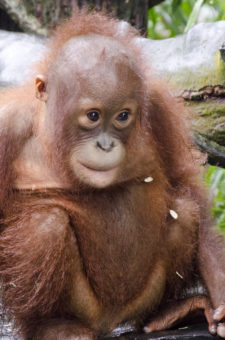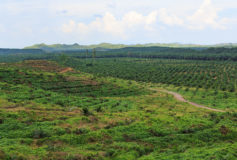Why is my first book about orangutans

I could tell you its because when I stared into the soulful eyes of one of the orangutans at the National Zoo, I fell in love. That’s true. I could tell you it is because these are among the most intelligent of animals excepting humans, and sometimes I wonder if we are really that much smarter. Also true. Or I could tell you it is because I was so intrigued by the reason these spectacular animals were on the critically endangered species list. And that gets me to plants.
People who know me say it always starts with the plants. Domestication of plant species, or farming, is what helped humans emerge from their precivilization origins. I have a curse for people who put down agriculture that goes like this: “May you starve to death and run naked in the streets.” But that doesn’t mean all agricultural strategies are good, and they can be disastrous. And that gets us back to orangutans and part of the reason they have found there way onto the critically endangered species list.
Short answer is palm oil.
Through geological history and evolution, orangutans have been isolated on two southeast Asian islands – Borneo and Sumatra. Their habitat is the rainforest—the place that produces a smorgasbord of fruits on which they dine. It is said that orangutans eat more than 300 different kinds of fruits. Interestingly, even though they have so much to choose from, there are times of the year when trees bear nothing, and these primates have to resort to leftovers— young leaves and shoots, insects, soil, tree bark, and occasionally eggs and small vertebrates. That’s enough of a challenge. What happens if the rainforest is chopped down and replace with a monoculture, which happens to be Elaeis guineensis—that’s the Latin name for palm oil trees.

Photo by CEphoto, Uwe Aranas
Palm oil is nothing new. The trees are thought to be native to West Africa. Vials of palm oil have been found in Egyptian tombs dating back 5,000 years! But the real market for palm oil blossomed with the beginning of the British Industrial revolution when its use as a lubricant became apparent. It still took almost another 100 years for production of palm oil to really take off. That gets us to the 1960’s.
Today palm oil is used in all kinds of cooking applications including baked goods, in soaps, detergents, candles, cosmetics, wound care products, as animal feed, as an industrial lubricant, and as a biofuel.
Unfortunately, in recent years, huge swaths of rainforest have been mowed down in these Indonesian Islands to make room for palm oil plantations. Indonesia is the biggest producer of palm oil in the world.
And you can guess what it means when you chop down the rainforest in Borneo and Sumatra. No place for orangutans to live. And nothing for them to eat. So, as I said at the beginning, it all starts with the plants.
– Written by Eva J. Pell








